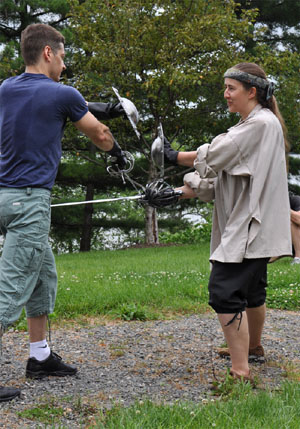
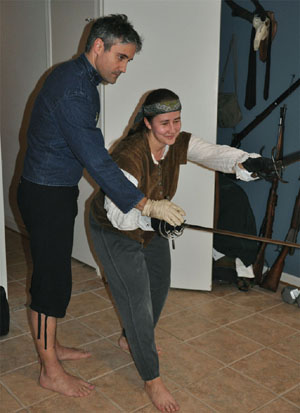
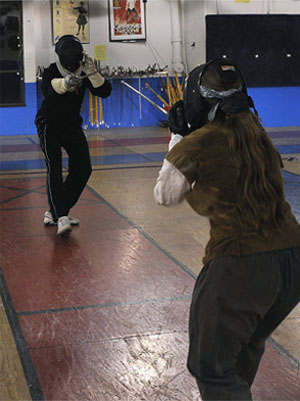
The Grand Journey
1.) Virginia
During my professional/research travels, I also expanded and deepened my historical swordsmanship studies, thus conducting what Greg (Mele) called "The Grand Journey." Before selecting certain schools, I visited several instructors focusing mainly on the systems of Italian Rapier and Bolognese Swordsmanship while I was doing research and attending conferences across the U.S. and Australia. (Here is the 2.) Australia part of my "Grand Journey" and here 3.) The "California Journey" report.)
The first three pictures summarize the predominant content of my private lessons with Steven Reich and Tom Leoni of the Order of the Seven Hearts as well as with William Grandy of the Virginia Academy of Fencing: Bolognese (single sword as well as sword and buckler based predominantly on The Anonymous) with Steve, Fabris (rapier as well as rapier and dagger) with Tom, and rapier fencing with Bill (complemented by just about anything else; Bill is all about diversity :-). Bill has also generously "adopted me" into activities around his academy, and his assistant instructors David, Pamela, and Kelly, as well as a few other Bill's learners were involved in my studies at the VAF. Bill has even switched the topics of his most advanced renaissance swordsmanship classes to selected Fabris topics during my two longest stays.
My visits to date ranged in length from a whole month to three single visits with each instructor during a trip to show around my brother, who was visiting from the Czech Republic. BTW, during this visit, I was able to "trick" Tom (whose family was visiting the same evening) by saying that no, I did not need him to call me a taxi because my brother was picking me up. However, I was not able to similarly trick Steve, who would not say his goodbyes and get into his car before seeing my brother with his own eyes. When it was revealed that my brother went sight-seeing to Washington, DC during our lesson at Tom's house, Steve loaded me into his car, and my brother had to pick me up at Steve's house. (The locals trust no-one when it comes to Washington, DC traffic situation, but feel free to ask how I have done when driving Bill and his friends throughout the city, and that even in the dark. In fact, I submit the locals complain only because they have not tried driving throughout Los Angeles, Seattle, and Chicago :-).
After my first visit, I was going to point out--for "further generations" of traveling students--how important it is to remember that in America, a door in front of which there is no parking space cannot possibly be the main entrance into a house :-). But it soon became apparent why Tom does not really need a functioning door bell at his main door either. This is because if you come to the *right* entrance :-), you will never even get to use the bell. While you are approaching the door, looking at your watch to make sure not to ring the bell too soon, at the exact pre-arranged time, Tom will open the door, all already dressed up and ready to begin your lesson... And it is not true that Tom is bad with emailing either :-). When I hinted at coming to study with them, both Tom and Steve got back to me enthusiastically the same day.
And why would I feel like "at home" in Virginia? The reasons
are many, but please note two details. One, see the Czech flag ![]() hanging over Bill's head at the Virginia Academy of Fencing? Second, see the
little map postcards placed on those two white "consoles" at the salle
in Tom's house? These show selected castles and historical cities, with their
coats of arms, within 1.) the whole Czech Republic, and 2.) the smaller included
region of Moravia, where I come from :-).
hanging over Bill's head at the Virginia Academy of Fencing? Second, see the
little map postcards placed on those two white "consoles" at the salle
in Tom's house? These show selected castles and historical cities, with their
coats of arms, within 1.) the whole Czech Republic, and 2.) the smaller included
region of Moravia, where I come from :-).
With Steve, we practiced mostly outdoors. During my various visits, the temperatures varied greatly--from sweltering to freezing. But no-one was thinking that could possibly slow us down, or even that snow and frost would prevent me from doing my homework, right?
Sometimes, Tom asked Steve to come to his house for my lessons as well, most notably when they were going to share the ways Tom and Steve practice together.
Other times, I had rapier "Fencing Clinic" sessions, whether at the VAF or at Bill's house, where some of our Bolognese stuff took place as well.
And, have I mentioned sword and dagger?
Recently, the "Pilgrimage of the Sword" folks--Scott (Aldinger) and Trevor (Pitts)--visited, and they also picked me up and took me along to check out one of the MASHS practices with Larry Tom. What a shame I took no pictures at the now cancelled practices of the Bumpers group with Brad Waller, with whom I even got to do a bit of abrazare the other time :-).
Right before my
departure from the area, following my longest visit, Bill dedicated one of his
VAF classes to an Antonie farewell event. It was a rapier tournament
almost entitled "Let us all beat up on Antonie." No, I am not going to
brag about how I placed, as it was not that important anyway. However, there was
a chance to receive "Technical Points" during this tournament for
setting up and landing a good hit in a *textbook perfect* way. This judging was
very strict, and only one Technical Point was awarded within the whole
tournament. I received it--for provoking an attack by means of a feint and
countering it with a contracavazione in contratempo.
The story of this counterattack actually began already the preceding Saturday,
when one of Bill's assistant instructors was telling me that I should not expect
to perhaps ever see people performing contracavazione in contratempo
counterattacks during free fencing. This fencer told me about pulling off said
action once in the person's lifetime (that is during free fencing), but at the
same time reckoned that most people would not make it. Therefore, following
Tom's then very recent advice that I should decide with which action I want to
defeat my opponent before we even cross blades, and then just go ahead and
execute that, I was bent on getting said fencer with the same action about which
that person was a kind of bragging.
In the competition, there were two rounds of bouts, which I had with each other
participant. During my first round with the pertinent fencer, I got to attempt
my little planned counterattack, but I missed. Still, it looked "textbook
perfect" enough for Bill to say that had I actually landed that thrust, he
would have given me a Technical Point for it. In the next round against the same
fencer, then, I managed to cleanly land my thrust the same way, and as a result,
I indeed received "my" Technical Point. At the same time, this
action--involving my feint with contracavazione in contratempo
counterattack--was the only single thing that transpired during our second bout!
Since everyone (Tom, Steve, and Bill) was then a kind of on a mission to help me
begin using some feints (which we I have never learned in the CSG), I thought
that everyone involved won this way. Additionally, the fact that I responded the
above-described way to someone's bragging, while I am now bragging myself,
perhaps means that I have learned something also about how to be a good
member of the WMA community. :-)
To the credit of my above-mentioned opponent in the above-described competition,
it must also be mentioned, however, that this person was nice enough to practice
with me exactly the same counterattack just a few days before our little
tournament. Also, this fencer has overall won the whole tournament (I was 2nd),
and I have to assume that this was because this person is always ready to fence
on all available occasions. In contrast, the instructors as well as other guys
at the VAF had been letting their rapier fencing "rust" (that is
*before* I came upon them! :-). Thus, it seems that the concluding
"morale" of my story is--well, surprising? :-) Practice, practice,
practice...
"Farewell to Antonie" social events became a tradition too. The first picture is from a dinner where I cooked Czech dishes for (from the left) Tom, Pamela, Bill, David, and Steve. This picture also shows the living room in Bill's own relatively new house as it looks when turned back to its original purpose (well, depending on what the original purpose really is; Bill did say he picked this particular house because the living room has high enough ceiling even for longsword). Since the Order of Seven Hearts got wiped out by the flu and such by the end of my most recent visit, the still standing Virginia Academy of Fencing took me to the Brickskellars,' a Washington, DC bar where they have the US most extensive selection of international beers. From left in the 2nd picture are Bill's girlfriend, Bill, I, Pamela, David, and Mark (Pamela's husband who fences as well). Please, note that they even had for me a booth with a ship in it (click here for why ships are important :-). Since picture-taking is not allowed when students are present at the VAF, I rather have all Bill's assistant instructors in the "social" pictures (although we took none at the Pamela's house movie night either). Kelly is missing from the first two pictures, but she, her husband, and her friend are in the last photo, taken at her house when Kelly's husband (in the middle) cooked a Chinese dinner for us.
And, since one day I should write a little Handbook for traveling WMA scholars (perhaps together with Scott Aldinger--with him specializing in the beating upon everyone and me in the learning from--selected ones topics), here is one pertinent tip. Not that I used it, although perhaps I should have :-). The Safe Answers chapter will detail what one should say if stuck. For example, should you have no clue what to respond while Tom is asking you what one should do tactically in a situation, just say feint, as at least 85% of times that is indeed the correct answer!
Should this handbook include entertaining quotes, many of Tom's truly sincere ones will have to remain private. But the following ones are (almost) publishable:
Tom: What do you do when your opponent finds your sword? Student: That depends on... Tom: I know you know all the options, but give me just the most obvious one. Student: Should you be able to move in the tempo of his finding, and while in measure, you attack with a cavazione di tempo. Tom: No. Feint! Feint, feint your @$$ off!
Rejoice! Now you are free from all those dictatorial rapier rules. If you can make an action work in a way (on a sound theoretical base), you are fine in Bolognese. Steve.
Tom: How large is supposed to be your cavazione? Student: Just large enough to go around whatever you need to go around. Tom: Yes, if you need to make a cavazione around an elephant, you make it just a bit larger than an elephant.
Student: I guess after I do about 5,000 of these, it will all work just fine? Steve: Now you are catching up!
Student:
I
have..., as I did not... where I should have rather... . Oh! That is what you
are saying, right?
Tom:
Yes,
I am leading the lesson :-).
So
you know what is your homework, right? When in doubt, cuts and steps.
Steve
Tom:
Fencing
is simple. You have about 6 actions and 4 lines, while the high line is rarely
used. So it is like you have three cans of soupchicken, rice, and beef
ravioli, which is the outside line, the inside line, and the low line. In order
to eat the soup, you need a can opener, so feint is the circular opener, and
attack is the opener with the teeth up and down. That is it.
However, concerning this little handbook, one thing is getting out of hand already. I have been compiling for myself a mental table, which used to have 3 basic columns. Corresponding to each line representing an action were columns East Coast, Midwest, and West Coast, which detailed how these actions are to be performed. Beginning with basic rapier actions, say attack in second, or even just finding in second, Tom, Steve, and Bill's ways were consistent although quite different from John's (meaning John O'Meara from the CSG). Other things, like parries, seemed to be simple (as all the East Coast guys and John were doing them the same way), but that only until I visited with Puck (Maestro Curtis), which is when the West Coast column was created. However, when we begun sword and dagger also with Bill, it became apparent that three columns will not be sufficient, as the way Bill classifies his dagger parries is the same as Pucks, but different from Tom's and Steve's. Now, when we get to Italian classical fencing, my handbook may really need to have excessive foldouts, as I may need a separate column for each Maestro :-). And that in addition to the more general columns: USA and Italy. And on the top of everything, all my tables may need another dimension like John 2006, 2008, 2010, etc...
And what for my final handbook preview note? (Assuming you are a good student), just go for it and never be too shy. Once I dared to inquire, no-one I asked (from the U.S., Australia, and Europe) ever turned me down (and no-one accepted my money either, although I always offered to compensate my instructors for their lessons). Should you be so brave enough for a while, you will not even have to continue being brave, as people then begin inviting you...
After the first couple of my Virginia visits, Tom and Steve came to Chicago to give seminars for the Chicago Swordplay Guild. Steve taught the Bolognese while Tom said he would come, but he would "teach feints all day long" (as he was very surprised to find out I had never practiced feints as such in Chicago). And so he did, although he otherwise shared his experience about how to practice in order to really internalize the Fabris material and its use in order to be able to incorporate it into actual fencing.
The second day of the seminars took place not in Pulaski Park (the venue of regular CSG practices) but in Greg and Nicole's house salle. Tom was then working on sword + dagger and sword + cape with the CSG rapier scholars, and Steve was giving an advanced Bolognese class.
I have been working with the "Virginia guys" also at events. First of all, I have taken a couple of rapier lessons from Bill Grandy at the Chivalric Weekend 2008. Unfortunately, no pictures were taken then, but when I returned from my first subsequent combined visit to Tom's, Steve's, and Bill's, and Greg asked me: "Where is my report?", I learned really fast to make sure to have pictures in the future...
In 2009, I attended my first ever Pennsic War. This was due to the "WMA in SCA" initiative, organized by the Company of Saint Jude, of which the mission is promoting historically-based swordsmanship studies within the Society for Creative Anachronism. Apart from Stephen Hick, Greg Mele, Scott Wilson, and other WMA instructors who were already attending the Pennsic, our two special guests were Tom Leoni and Steve Reich.
The below featured classes were on Iberian Montante (Steve Hick), Spadone, Fabris Rapier (feinting and cutting classes), High-Renaissance Polearms (Tom), Sword and Buckler (Steve Reich), Bolognese Spear (Greg), and Fiore Longsword (Scott).
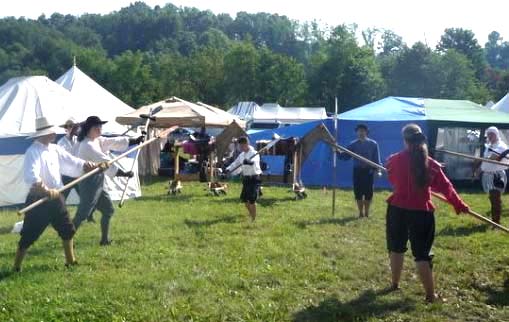
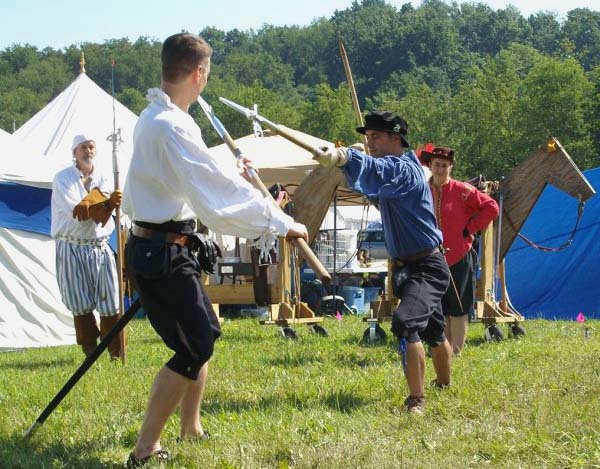
Since this is the only site with any pictures from my first, and so far also last, Pennsic War attendance, please find a few also from our Casa Bardici camp visit.
So no, I have not cheated on my whole Pennsic 2009 attendance by really spending it as a little WMAW. Among other activities, and in addition to performing with the madrigal group Pippins several times, I also sung with the Known World Choir. Through clicking here, a site with recordings of our KWC 2009 Pennsic concert can be found.
And then...the WMAW 2009 was the event of the great sword (where Craig delivered my Spadone :-). In addition to Tom (Leoni) and Steve (Reich) with the Spadone, Stephen Hick and Eric Myers with Puck Curtis and Kevin Murakoshi on his Iberian Montante crew became involved in my "great sword adventure." And before the WMAW was over, Eric, Puck, and Kevin invited me to visit with them in California, thus this story continues within the "California Journey report" (click here).
And yes, the middle picture (in the upper row) illustrates why I have heard a suggestion like: "Antonie, you need a bigger sword" from almost half the WMAW participants (I submit that the fact that Christian Tobler made a much smarter and insightful remark is quite possibly related to the fact that Jessica Finley is his student). In any case, can you think of a better-suited weapon than is the Spadone for an inherently defensive swordsman? The lower two pictures then, are from 4W 2010.
So have I been slacking on my rapier then? Of course not! I even have evidence. For one, a friend has sent me a picture of Sean Hayes with me and my fencing partner George during the coached fencing sessions at WMAW. In addition, Sean Hayes was able to give me a private lesson while staying in Chicago for a few days after the event. I do not have any documentation of my individual work with Guy Windsor, but there will be further such picture-taking opportunities when I move back to Europe... :-).
Of course, I was participating in classes at the WMAW as well. In fact, similarly to my 2007 WMAW, I have not missed a single time slot in which a class or other fencing took place, except when I was receiving private lessons instead. The provided example of my classes picture Stefan Dieke's Meyer Rapier session. And our conversation with Stefan, held while I was giving him a ride to the airport, was one of the absolute WMAW highlights. It was not done on purpose but rather due to my GPS confusion that I "dragged" him the longer way along the lake. But I am glad we thus got to talk as long as we did--about different pedagogical approaches to teaching within the WMA community.